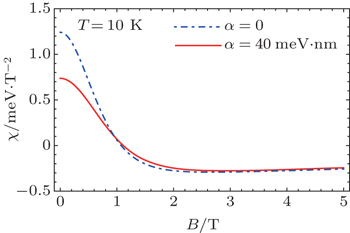† Corresponding author. E-mail:
Project support by the University Grants Commission, India, the Department of Science and Technology, and the University Grants Commission–Basic Science Research (UGC-BSR).
The thermodynamic properties of an InSb quantum dot have been investigated in the presence of Rashba spin–orbit interaction and a static magnetic field. The energy spectrum and wave-functions for the system are obtained by solving the Schrodinger wave-equation analytically. These energy levels are employed to calculate the specific heat, entropy, magnetization and susceptibility of the quantum dot system using canonical formalism. It is observed that the system is susceptible to maximum heat absorption at a particular value of magnetic field which depends on the Rashba coupling parameter as well as the temperature. The variation of specific heat shows a Schottky-like anomaly in the low temperature limit and rapidly converges to the value of 2kB with the further increase in temperature. The entropy of the quantum dot is found to be inversely proportional to the magnetic field but has a direct variation with temperature. The substantial effect of Rashba spin–orbit interaction on the magnetic properties of quantum dot is observed at low values of magnetic field and temperature.
Recently, advances in nano fabrication techniques have made it possible to design various kinds of quantum dots with the flexibility of tuning the size, shape and number of electrons.[1–4] There are two different strategies for creating these zero-dimensional nanostructures in a controllable and repeatable manner: “top-down” and “bottom-up” techniques.[5,6] The top-down techniques include extreme ultraviolet or even hard x-ray lithography,[7] electron-beam writing, or microcontact stamping,[8] and can only create nanostructures down to the sub-100-nm range. Another method is used to efficiently guide the atoms or molecules into nanometer-scale structures through the assembly process.[9] The reduction of dimensionality in these structures leads to the formation of discrete energy levels[10] and subsequently drastic changes of the optical as well as many novel physical properties.[11–13] These tunable properties of the quantum dot make it a promising candidate for various device applications, which have been extensively explored in the last few decades.[14–19]
In addition to dimensionality, spin-dependent interactions also play an observable role in the energy spectrum formation of elecrons confined in a quantum dot.[20–22] The coupling between the spin–moment and magnetic field which appears in the rest frame of the electron due to its motion through the electric field gives rise to Rashba spin–orbit interaction.[23,24] In a quantum dot, the electric field can arise in two ways.[25,26] One is from structural inversion asymmetry due to which the electric-field points towards the growth direction and restricts the motion of electrons to a two-dimensional plane. Another source of electric field is the lateral confinement potential giving rise to an in-plane electric field.[27] If the confinement is rotationally symmetric, it will be parallel to the radius vector
There have been several experimental and theoretical studies devoted to the thermodynamic properties of quantum structures,[30–37] but the theoretical understanding of the effect of SOI on these properties is still in its infancy. Gornik et al.[30] have reported the first observation of magnetic-field-dependent specific heat (Cv) in quasi two-dimensional objects. Intra as well as inter-Landau level contributions to (Cv) are recognized which reveals a density of states with Gaussian broadening. Liao[34] has investigated the heat capacity of horizontally absorbed molecules in the presence of a static electric field. The magnetization of nanoscopic quantum rings and dots has been calculated by Climente et al.[35] A change in topology leads to a sharp response in the magnetization and thus suggesting the use of it for probing the topology of nanocrystals. Boyacioglu and Chatterjee[36] have studied the specific heat and entropy of the GaAs quantum dot with Gaussian confinement in the presence of an external magnetic field but neglecting the spin–orbit interaction. To the best of our knowledge, no exhaustive study for the role of Rashba SOI on the thermodynamic properties of quantum dots has been made so far.
In this paper, we analyze the thermodynamic properties exhibited by a quantum dot in the simultaneous presence of a magnetic field and Rashba SOI. The approach is to first calculate the energy spectrum of the quantum dot system and then use the partition function formalism to uncover its thermodynamic behavior. We investigate the properties of a circular quantum dot carved out of a two-dimensional heterostructure in which it is assumed that electrons are strictly confined to the two-dimensional plane. Although in the physical realm, electron wave-functions have a finite spread in the perpendicular direction of this plane but the small dimension restricts the electrons to the lowest subband and all electrons exhibit exactly the same behavior in this direction. Therefore, single-particle properties are unaffected by the spreading of wave functions and our assumption sounds plausible. Here, we have incorporated the spin–orbit term only due to the parabolic confinement and therefore the system Hamiltonian is diagonal in spin space.
The paper is organized as follows. In Section 2, we present the mathematical formalism for our system. In Section 3, we analyze the numerical results obtained for a quantum dot of InSb and then conclude our findings with specific remarks in Section 4.
In order to model the confinement of charged particle within the small region of circular quantum dot of radius, the particle is assumed to be moving in a parabolic potential of the Fock–Darwin type[38] given by














For thermodynamical calculations, we fix the external conditions of the single electron quantum dot by considering it a closed system in contact with a heat bath at temperature T. The canonical partition function giving a measure of thermally accessible energy states is defined as














In our numerical investigation, we choose an InSb quantum dot with m(E) = 0.014m0, Eg = 0.24 eV, Δ = 0.81 eV,[20] and radius R = 14.8 nm. The small effective mass and high g factor of InSb make it one of the most promising materials for application in spintronics[40] and spin-based quantum information technology.[41] In the presence of an external magnetic field and Rashba SOI, the behavior of charged particle in a parabolic quantum dot can be described as harmonic oscillator with frequency which is a function of not only confinement potential and magnetic potential but also depends on Rashba SOI. This interaction can enhance or reduce the oscillator frequency through Ωσ depending on the particle spin orientation. Another contribution of SOI comes from the last term of Eq. (
In Fig.
 | Fig. 1. Variation of specific heat of InSb quantum dot with magnetic field at temperature T = 5 K, 10 K, and 20 K with Rashba spin–orbit coupling parameter α = 40 meV·nm. |
In Fig.
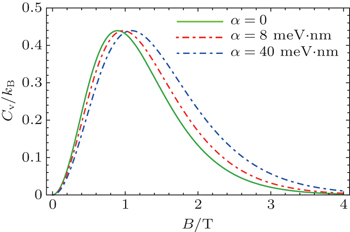 | Fig. 2. Specific heat of InSb quantum dot as a function of magnetic field for different values of Rashba spin–orbit coupling parameter (α) at temperature T = 10 K. |
In Fig.
When the magnetic field is increased to 5 T, specific heat remains zero in the region where it peaks for the low magnetic fields B = 0.5 T and 2.0 T. Instead a shoulder is developed in a temperature range of 10–50 K. This can be attributed to the broadening of energy spacing between the different Landau levels in a high magnetic field. In the upper range of temperature, the behavior of specific heat is more or less the same for all the three magnetic fields and is reminiscent of 3D behavior of Cv. Electrons have sufficient thermal energy and therefore excitations have a little dependence on density of states.
In Fig.
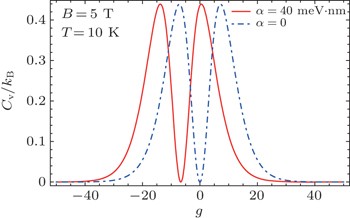 | Fig. 4. Variation of specific heat with Lande’s g factor for α = 0 (blue) and α = 40 meV·nm (red) at B = 5 T and temperature T = 10 K. |
Next, the thermodynamic quantity of interest on which we have studied the effect of Rashba SOI is entropy. Variation of entropy with respect to the magnetic field at temperatures T = 10 K, 50 K, and 100 K is shown in Fig.
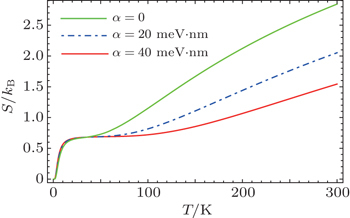 | Fig. 6. Entropy as a function of temperature with different values of Rashba spin–orbit coupling parameter. |
We further studied the variation of magnetization (M) and susceptibility with magnetic field. In Fig.
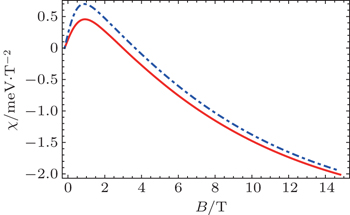 | Fig. 7. Magnetization (M) of InSb quantum dot as a function of external magnetic field with α = 40 meV·nm and 0 meV·nm. Solid and dashed lines represent M with and without Rashba SOI. |
We have studied the effect of Rashba spin–orbit interaction and static magnetic field on the specific heat, entropy, magnetization and susceptibility of InSb quantum dot. An interesting interplay of Rashba spin–orbit coupling parameter, magnetic field, and temperature is observed in determining these thermodynamic properties. We observe that qualitative variation of specific heat with magnetic field is the same as the increase in either temperature or Rashba SOI. A direct consequence is that the absorption of heat by a quantum dot can be improved either with the temperature or Rashba spin–orbit coupling parameter. At low magnetic field, the variation of specific heat with temperature gives a peak-like structure. The Rashba SOI sharpens this peak and shifts it to the lower value of temperature. Entropy is found to increase with the temperature but we observe that Rashba SOI can nullify the effect of temperature. As a result, entropy can maintain a constant magnitude for a certain range of temperature. This property is useful where one requires a temperature as high as possible but entropy has to be minimum. The magnetic properties of the system are found to be more susceptible to the Rashba SOI at low values of temperature and magnetic field. These are often assumed to be intrinsic. The ability to externally control the properties of magnetic materials would be highly desirable from fundamental and technological viewpoints, particularly in view of the recent developments in magneto–electronics and spintronics.
| 1 | |
| 2 | |
| 3 | |
| 4 | |
| 5 | |
| 6 | |
| 7 | |
| 8 | |
| 9 | |
| 10 | |
| 11 | |
| 12 | |
| 13 | |
| 14 | |
| 15 | |
| 16 | |
| 17 | |
| 18 | |
| 19 | |
| 20 | |
| 21 | |
| 22 | |
| 23 | |
| 24 | |
| 25 | |
| 26 | |
| 27 | |
| 28 | |
| 29 | |
| 30 | |
| 31 | |
| 32 | |
| 33 | |
| 34 | |
| 35 | |
| 36 | |
| 37 | |
| 38 | |
| 39 | |
| 40 | |
| 41 | |
| 42 |





